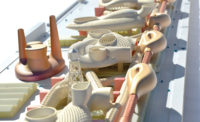On the morning of May 24, as the clouds scattered over Venice, transforming the backdrop of the Giardini into a glorious, clear-aired day, attendees and participants gathered for the official opening of the U.S. Pavilion in front of the 1930 neoclassical building. The individuals behind the effort in attendance were many and diverse: representatives from the State Department, the presidents of the commissioning schools: the School for the Art Institute of Chicago (SAIC)'s Elissa Tenny and the University of Chicago's Robert Zimmer, as well co-curators Mimi Zeiger from Los Angeles, Niall Atkinson (University of Chicago), Ann Lui (SAIC), and dozens of the designers involved.
In response to the Biennale’s overall theme, “FreeSpace,” the U.S. pavilion is dedicated to exploring the notion of “Dimensions of Citizenship.” “We all occupy different, overlapping categories of space at the same time, from the level of the neighborhood, to the nation, to the planet as a whole,” state the curators. For the exhibition, they have assembled seven design teams, which explore the theme at seven different scales, from the body to the cosmos (drawing inspiration from the Eames' film “Powers of Ten”), to present a telescopic understanding—and potential—of the place of different peoples on the planet. In this survey, says Zeiger, “we must reconcile with issues of inclusion and exclusion.”
The teams have captured a wide range of the parameters of citizenship, bypassing the most mundane, which are the boundaries of nations. Starting in the pavilion's entry courtyard, artists Amanda Williams and Andres L. Hernandez of Chicago, who collaborated with artist Shani Crowe, present the idea of “black women/space matters,” with a beehive-shaped form of steel, covered in black and gold paracord, braided and fashioned in manners inspired by African-American hairstyles. The installation—actually the only built structure in the exhibition— investigates how race shapes notions of identity, shelter, and public space in historically African-American communities.
At the other end of the spectrum, architects El Hadi Jazairy and Rania Ghosn of Design Earth take a different approach. As if gazing through a telescope, they present speculative designs for the cosmos with “Cosmorama,” which questions how one engages in exploration of the universe as human and ecological systems become more unstable on earth.

And then there is everything in between: Studio Gang looks at “civitas”—employing cobblestones from a historic site in Memphis, Tennesee, to show how the design of urban public spaces intersects with people's history and empowerment; SCAPE’s project on the level of the regional, is a case study of the ecological changes of the Venetian Lagoon; Estudio Teddy Cruz + Fonna Forman examines the U.S./Mexican border as a boundary-less environmental area, “challenging the idea that the edge of a nation demands a wall,” as curator Lui puts it. Diller Scofidio + Renfro, with Laura Kurgan and Robert Pietrusko, confront conventional demographic data by using satellite images and mapping to visualize, on a global scale, where people actually live or migrate; and, finally, Keller Easterling, noting how the digital world transcends national borders, proposes new means for connecting global citizens and resources.
“We hope,” said Zeiger as the doors were just about to be officially flung open, “that the exhibition will provide a new understanding of citizenship and potent new territory for design.”
Coverage of the 2018 Venice Architecture Biennale sponsored by Hunter Douglas Architectural.



















Post a comment to this article
Report Abusive Comment